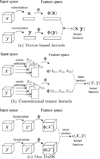DuSK: A Dual Structure-preserving Kernel for Supervised Tensor Learning with Applications to Neuroimages
- PMID: 25927014
- PMCID: PMC4410984
- DOI: 10.1137/1.9781611973440.15
DuSK: A Dual Structure-preserving Kernel for Supervised Tensor Learning with Applications to Neuroimages
Abstract
With advances in data collection technologies, tensor data is assuming increasing prominence in many applications and the problem of supervised tensor learning has emerged as a topic of critical significance in the data mining and machine learning community. Conventional methods for supervised tensor learning mainly focus on learning kernels by flattening the tensor into vectors or matrices, however structural information within the tensors will be lost. In this paper, we introduce a new scheme to design structure-preserving kernels for supervised tensor learning. Specifically, we demonstrate how to leverage the naturally available structure within the tensorial representation to encode prior knowledge in the kernel. We proposed a tensor kernel that can preserve tensor structures based upon dual-tensorial mapping. The dual-tensorial mapping function can map each tensor instance in the input space to another tensor in the feature space while preserving the tensorial structure. Theoretically, our approach is an extension of the conventional kernels in the vector space to tensor space. We applied our novel kernel in conjunction with SVM to real-world tensor classification problems including brain fMRI classification for three different diseases (i.e., Alzheimer's disease, ADHD and brain damage by HIV). Extensive empirical studies demonstrate that our proposed approach can effectively boost tensor classification performances, particularly with small sample sizes.
Figures






References
-
- Cai D, He X, Han J. Computer Science Technical Report UIUCDCS-R-2006-2716. University of Illinois at Urbana-Champaign; 2006. Learning with tensor representation.
-
- Chong E, Zak S. An introduction to optimization. Wiley interscience; 2001.
-
- Cichocki A. Tensors decompositions: New concepts for brain data analysis? Journal of Control Measurement, and System Integration. 2013;7:507–517.
-
- Davis J, Dhillon I. Structured metric learning for high dimensional problems. Proceeding of the 14th ACM SIGKDD international conference on Knowledge discovery and data mining; Las Vegas; Nevada, USA. 2008. pp. 195–203.
-
- Guo W, Kotsia I, Patras I. Tensor learning for regression. IEEE Trans. Image Processing. 2012;21(2):816–827. - PubMed
Grants and funding
LinkOut - more resources
Full Text Sources
Other Literature Sources
